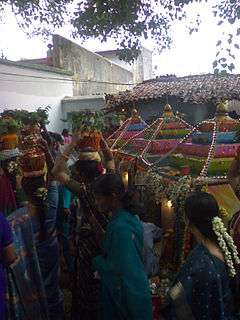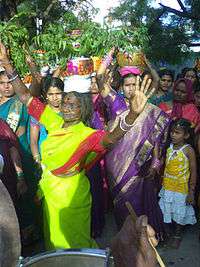Bonalu
| Bonalu | |
|---|---|
 Women with Bonam performing parikrama | |
| Official name | Bonalu |
| Observed by | Telangana |
| Type | Festival of Goddess Kali |
| Celebrations | on Sundays |
| Observances | Offering to the Goddess |
| Begins | Ashada masam (July/August) |
| 2016 date | July 10-July 31 |
| Frequency | annual |
Bonalu or Goddess Mahankali bonalu [1] (Telugu: బోనాలు ) is a Hindu Festival, Goddess Mahakali is worshiped.[2] Bonalu is an annual festival of Telangana celebrated in Twin Cities Hyderabad, Secunderabad and other parts of Telangana, India.[3] It is celebrated in the month of Ashada Masam, in July/August. Special poojas are performed for Yellamma on the first and last day of the festival.[4] The festival is also considered a thanksgiving to the Goddess for fulfillment of vows.
The word Bonam is a corruption of the word Bhojanam(a Sanskrit loanword) which means a meal or a feast in Telugu, is an Offering to Mother Goddess. Women prepare rice cooked with Milk,Jaggery a New Brass or Earthen Pot adorned with Neem Leaves,Turmeric,Vermilion and a lit lamp on the top of the Pot. Women carry the pots on their heads and make offering of Bonam along with Turmeric-Vermilion,Bangles and Saree to the Mother Goddess across the Temples.
Bonalu involves the worship of Mother Goddess in regional forms like Mysamma, Pochamma, Yellamma, Peddhamma, Dokkalamma, Ankalamma, Poleramma, Maremma, Nookalamma.
The 2016 dates for it are July 10-July 31.[5]
Origin of Bonalu festival
The history of the origin of this festival traces back to the 19th Century, and is linked with the "Regimental Bazaar" and the twin cities of Hyderabad and Secunderabad. In the year 1813, plague disease broke out in the twin cities, and this took away the lives of thousands of people. Just before this, a military battalion from Hyderabad was deployed to Ujjain. When this Hyderabadian Military Battalion got to know about the epidemic in the cities, they prayed to the Mother Goddess in Mahankaal Temple - Ujjain, Madhya Pradesh. History tells us, that this military battalion prayed to Goddess Mahankaali, to kill plague, and if the Goddess would do so, they had decided to install and idol of Goddess Mahankaali in the city. It is believed that Mahankaali destroyed the disease and kept pestilence at arms length. Then, the military battalion returned to the city & installed an idol of the goddess, which was followed by the offering of Bonalu to her. Hence, from then, this had turned a tradition, which has been followed and is still being followed by all the people belonging to Telangana.
Other versions also include the mythological story and belief that revolves around the festival, says that this is the time when Goddess Mahakali comes back to her parental home, in Ashada Maasam or the period from late June to August, and so, this period is the most optimal time to offer Bonalu to the goddess. This can be compared to the treatment of a girl, who is married, and then returns to her birthplace, and is pampered by her parents.
The Ritual
Bonalu is celebrated in various parts of the city. On the first Sunday of Aashadham, celebrations are held at the temple at Golconda Fort, Telangana State in India. On the second Sunday, at Balkampet Yellamma temple in Balkampet and Ujjaini Mahakali Temple in Secunderabad and the third Sunday, at The pochamma and katta maisamma temple of chilkalguda and the Matheswari temple of Lal Darwaza in Old City of Hyderabad. Akkanna Madanna temple in Haribowli, Muthyalamma temple in Shah Ali Banda are among other temples where Bonalu are celebrated. Every year, lakhs of devotees congregate to pay obeisance to Mahankali.
On this special occasion women dress up in the traditional Sari combining it with jewels and other accessories. Teenage Girls wear Half-Sarees/Lehenga Choli combining it with jewels in order to bring out the traditional grace of the attire.
Some Tranced women dance with balancing pots (Bonam), to the rhythmic beats of drums in honour of the local Goddess. To ward off evil spirits, in olden days, people used to sacrifice a male buffalo in front of the temple, but now, roosters are sometimes sacrificed.
Women carrying Bonalu are believed to possess the spirit of Mother Goddess, and when they go towards the temple, people pour water on their feet to pacify the spirit, who, by nature, is believed to be aggressive.
Every group of devotees offer a Thottelu (a small colorful, paper structure supported by sticks), as a mark of respect.
It is believed that the Goddess comes back to her maternal home during Ashada Maasam, so people come to see her and bring offerings of food to show their love and affection, just as they would prepare a special meal when their own daughters visit them.
The Bonalu celebrations at "Lashkar" Secunderabad twin city of Hyderabad is one of the most prominent bonalu celebrated in the month of Ashadam (June-July). The festival begins on the first Sunday of the Hindu Month of Ashada which is known as Edurukolu i.e. the home coming of goddess in the form of Ghatam is celebrated and on the third Sunday of the Ashada month Bonalu Jatara is celebrated and on the following Monday Rangam (Oracle) and Ghatam Saganamputa are celebrated and the festivities come to an end. The prominent temples in the Secunderabad "Lashkar Bonalu" include Sri Ujjaini Mahakali Devasthanam Secunderabad, Sri Devi Pochamma Temple Somasundaram Street Secunderabad, Sri Muthyalamma Temple at Kalasiguda, Sri Peddamma Temple at Bata cross roads, Sri Dokkalamma Temple Shivaji Nagar, Sri Muthyalamma temple Ashok Nagar, Sri Peenugula Mallanna Temple near Railway Station, etc. Out of these temples Sri Ujjaini Mahakali Temple and Sri Devi Pochamma Temple Somasundaram Street are Government temples where festivities are visited by Government officials and legislators.
Pothuraju

Potharaju is the brother of Mother Goddess, is represented in the procession by a well-built, bare-bodied man, wearing a small tightly draped red dhoti and bells on his ankles, and anointed with turmeric on his body and vermilion on his forehead. He dances to resounding drums.[6]
He always dances before the Palaharam Bandi, the procession. He is considered the initiator of the festivities and the protector of the community. He leads the tranced female dancers who are under spell of the Mother Goddess (known as shigam) to the temple, with lashing whips and emerald neem leaves (margosa) tied around their waists, accompanied by trumpets and drums.[7]
The Feast
Bonalu is a festival of offering to the Mother Goddess and families share the offering with family members and guests. A non-vegetarian family feast follows after the great the offering. The meat used to prepare the meal is the meat of a goat or a chicken which is offered ceremonially (Bali in Telugu) to goddess and it is considered sacred. Offering alcohol is also considered a must. [8] The offerings are made to goddess most importantly toddy - Palm Tree wine is offered along with fowls, sheep and goat. In earlier days gory sacrifices of water buffaloes and sheep, etc. were offered however with the advent of modernization and strict government control over the prevention of animal sacrifices most of the sacrifices near temple are stopped however people substitute these animals with pumpkins, bottle gourds, coconuts and lemons.
The festival environment is quite palpable in the locality celebrating the festival, with loud-speakers playing Mother Goddess songs in folk style, and streets are decorated with neem leaves.
Rangam
Rangam or Performing the Oracle, is held the next morning of the festival. A Women standing atop of an earthen pot invoked goddess Mahankali onto her and performs the custom. She foretells the year ahead when devotees ask about the future. This takes place before the procession is started.[9] The present oracle at Sri Ujjaini Mahakali Devasthanam and other major temples of Secunderabad is Kumari Erupula Swarnalatha who is currently the 6th generation oracle teller. Previously oracle was performed by her elder sister Kum. Swaroopa before her, her grandmother Bagamma and other ancestors include Jogamma, Poshamma.
Ghatam
Ghatam is a copper pot, decorated in the form of mother goddess. The Ghatam is carried by a priest, who wears a traditional Dhoti and body with smeared in turmeric . The Ghatam is taken into procession from first day of the festival till last day, when it is immersed in water . The Ghatam in usually accompanied by drums.[10]
Ghatam is followed after Rangam. The festival concludes with immersion of Ghatam. The ghatam of Haribowli's [[Akkanna Madanna Temple] ][11][12] leads the procession, placed atop an elephant and accompanied by mounted horses and models depicting Akkanna and Madanna. It ends in the evening with a glittering procession and display followed by immersion of ghatams at Nayapul.[13]
A carnival-like atmosphere, where thousands of people wait along the main streets of Laldarwaza to Nayapul and watch the exquisitely and elaborately decorated Ghatams. Young men dance in a unique style to the drum beats and folk songs alongside Pothuraju, dress-up in various mythological roles.
The Ghatams of the Secunderabad City (Lashkar)include Ujjaini Mahakali & Mahadevi Pochamma at Karbala Maidan, Dokkalamma at Himam Bavi, Muthyalamma at Kalasiguda, Nallagutta, Pan Bazar, Chilkalguda, Uppara Basthi, Kummariguda, Regimental Bazar and Bhoiguda, etc.
There are areas in Secunderabad that existed from during the British era, Areas in Secunderbad cantonment also have their own dates for celebrating bonalu in their villages like Mudfort, Gunrock, Sikh Village ( which are now areas in the cantonment ). They celebrate ghatam procession just for one day or two days or so depending on their age old traditions. Thiru thulkanthamman Temple in Old Mudfort has been doing ghatam since for about 100 years.
The Ghatams of the Old city procession include the Mahankali temples in Haribowli Akkanna-Madanna, Laldarwaza, Uppuguda, Miralam Mandi and Kasaratta, the Jagadamba temple of Sultanshahi, Bangaru Mysamma temple of Shalibanda, Alijah Kotla and Gowlipura, and Sultanshahi, Darbar Mysamma of Aliabad, Mysamma Temple of Boggulkunta (FGP) and Mutyalamma temple of Chandulal Bela.
Thottela
thottela is also a part of the festival bonalu,its one the offerings to the goddess it is artifact of telangana people which is made of the bamboo sticks and colorful transparent papers it looks like a temple doom which is called as thottela.
Gallery
-

lal darwaza bonala pandaga Hyderabad
-

lal darwaza bonala pandaga Hyderabad
-

lal darwaza bonala pandaga Hyderabad
-

lal darwaza bonala pandaga Hyderabad
-

lal darwaza bonala pandaga Hyderabad
-

lal darwaza bonala pandaga Hyderabad
-

lal darwaza bonala pandaga Hyderabad
-

lal darwaza bonala pandaga Hyderabad
-

lal darwaza bonala pandaga Hyderabad
-

lal darwaza bonala pandaga Hyderabad
-

lal darwaza bonala pandaga Hyderabad
-

lal darwaza bonala pandaga Hyderabad
-

lal darwaza bonala pandaga Hyderabad
-

lal darwaza bonala pandaga Hyderabad
-

lal darwaza bonala pandaga Hyderabad
-

lal darwaza bonala pandaga Hyderabad
-

lal darwaza bonala pandaga Hyderabad
-

lal darwaza bonala pandaga Hyderabad
-

lal darwaza bonala pandaga Hyderabad
-

lal darwaza bonala pandaga Hyderabad
-

lal darwaza bonala pandaga Hyderabad
-

lal darwaza bonala pandaga Hyderabad
-

SC ST Association swagatha vedika.
References
- ↑ "History of Mahankali Bonalu in English". TNP LIVE. Hyderabad, India. 26 July 2015.
- ↑ "Explored Telangana Ashada Bonalu History & videos". 1 August 2016.
- ↑ http://www.telanganastateinfo.com/telangana-festivals/
- ↑ http://www.hinduonnet.com/thehindu/lf/2002/08/05/stories/2002080501520200.htm
- ↑ http://www.hinduutsav.com/2016/06/bonalu-2016-dates.html
- ↑ http://www.hindu.com/2006/07/24/stories/2006072415410200.htm
- ↑ http://www.hindu.com/2007/03/28/stories/2007032816230500.htm
- ↑ http://www.hindu.com/2008/10/11/stories/2008101153840500.htm
- ↑ http://www.hindu.com/2004/07/11/stories/2004071113180300.htm
- ↑ http://www.expressbuzz.com/edition/story.aspx?Title=Secunderabad+awash+in+Bonalu+colours&artid=nL|o77EMwEg=&SectionID=e7uPP4|pSiw=&MainSectionID=fyV9T2jIa4A=&SectionName=EH8HilNJ2uYAot5nzqumeA==&SEO=[]
- ↑ http://www.hindu.com/2006/07/15/stories/2006071522130200.htm
- ↑ http://akkannamadannatemple.com/history.html
- ↑ http://www.hindu.com/2007/08/06/stories/2007080657970200.htm
External links
| Wikimedia Commons has media related to Bonalu. |